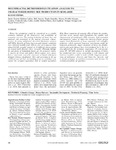
Please use this identifier to cite or link to this item:
http://ricaxcan.uaz.edu.mx/jspui/handle/20.500.11845/916| Title: | Multifractal Detrended Fluctuation Analysis to Characterize Honey Bee Production in Semi-arid Ecosystem |
| Authors: | Medina Cuéllar, Sergio Ernesto Tirado González, Deli Nazmín Portillo Vázquez, Marcos Tirado Estrada, Gustavo Medina Flores, Carlos Aurelio Venegas Venegas, José Apolonio Ramos Parra, Miguel |
| Issue Date: | Jul-2018 |
| Publisher: | Asociación Interciencia |
| Abstract: | Honey bee production could be considered as a reliable economic indicator of the biodiversity and availability of ecosystem services. The scaling behaviour of honey bee was analysed and associated to the natural ecosystem characteristics by using multifractal detrended fluctuation analysis (MF-DFA). Records of honey harvests and climatic conditions were collected monthly from 1998 to 2012 of 83 apiaries (Database= 14,940 records) located in 24 different micro-regions (in central-north Mexico) where ‘mesquite’ (Prosopis laevigata) and plants of Asteraceae family are the primarily endemic sources of nectar and pollen. Micro-regions were classified as semi-warm semi-arid, semi-arid, or humid subtropical (Köppen Climate clasification; KC), and according to the agricultural uses of their surrounding areas as secondary vegetation (S), irrigated agriculture (IA) or rainfed agriculture(RA). Hurst exponents of segments (Hq) of honey bee production time series showed small fluctuations but random walk characteristic of multifractal (MF) structure. Left truncation and parameter values of honey bee harvests fractal spectra suggest local fluctuations of large magnitude with self-affine properties which represent long-term correlations useful for long-term predictions. Major variations of honey bee production in semi-arid climates have been produced by S, but it is also affected for the minimum temperature (T) and precipitation (P). MF-DFA allowed to identify fluctuations in honey bee production time series, associating it with climatic and land use variables, useful to make reliable long-term predictions of pollinators’ diversity and honey bee harvests, and to design strategies to maintain ecosystems and increase the economic feasibility of apiculture. |
| URI: | http://localhost/xmlui/handle/20.500.11845/916 |
| ISSN: | 0378-1844 2244 – 7776 |
| Other Identifiers: | info:eu-repo/semantics/publishedVersion |
| Appears in Collections: | *Documentos Académicos*-- UA Veterinaría |
Files in This Item:
| File | Description | Size | Format | |
|---|---|---|---|---|
| INTERCIENCIA-MEDINA-CUÉLLAR-43_07 PUBLICADO.pdf | 601,33 kB | Adobe PDF |  View/Open |
This item is licensed under a Creative Commons License
